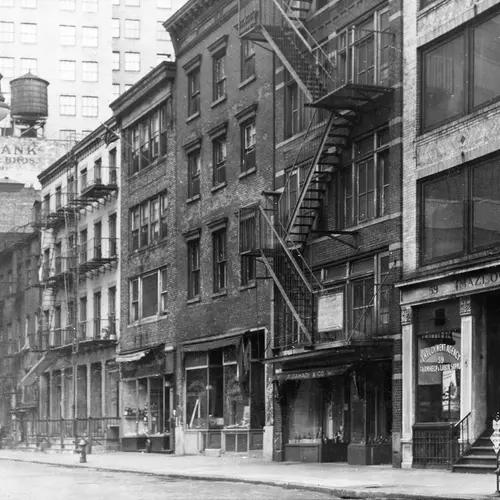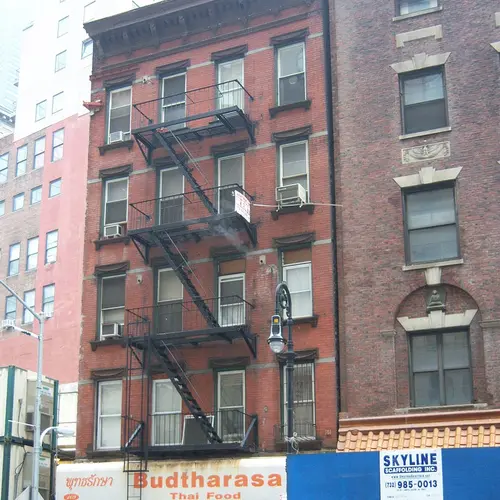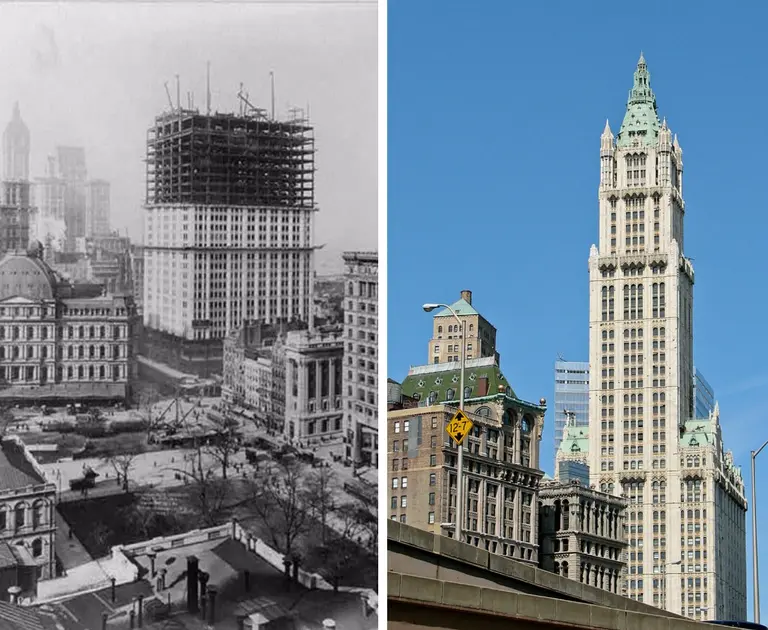Six things you didn’t know about the Lower West Side

59-81-Washington-Street ca. 1935, via NYPL
This post is part of a series by the Historic Districts Council, exploring the groups selected for their Six to Celebrate program, New York’s only targeted citywide list of preservation priorities.
The Lower West Side may not be a neighborhood name used by brokers, but for those involved with preservation efforts in the area, it’s a neighborhood very much unique from the surrounding Financial District. Encompassing the area west of Broadway from Liberty Street to Battery Place, it was originally home to Irish and German immigrants, followed by Little Syria, the nation’s first and largest Arabic settlement, from roughly the 1880s to 1940s. But the construction of the Brooklyn Battery Tunnel and World Trade Center “nearly wiped the neighborhood off the map.” There are still several buildings remaining that serve as a connection to the past, however, and Friends of the Lower West Side is working diligently to make sure this history is not lost, expanding its oral history program, offering walking tours of the area, and appealing to the Landmarks Commission to designate a small historic district.
 Map Courtesy of the Arab National Museum
Map Courtesy of the Arab National Museum
1. It’s one of Manhattan’s oldest and most diverse neighborhoods.
Due to its location at the tip of Manhattan, its development history goes back to the earliest European settlement of what is now New York City. Until around 1820, the Lower West Side was a high-end, wealthy neighborhood, and beginning in the late 18th century, immigrants settled on the Lower West Side because of its proximity to Castle Garden and Ellis Island. In the first half of the 19th century, as residents became successful and moved away from the busy harbor, their homes were converted to multi-family tenements to accommodate new waves of immigrants. In the 1840s, Irish and Germans began to arrive in large numbers, followed in the 1880s by groups from the Ottoman Middle East, as well as Eastern Europe, including Moravians, Czechs, Poles, Slovaks, and Rusyn. By 1917, 27 nationalities were represented in the neighborhood that stretched from Liberty Street to Battery Park and from Broadway to the Hudson River.
 A man wearing a fez selling drinks in Little Syria in the early 1900s, courtesy of the Library of Congress’ Bain Collection
A man wearing a fez selling drinks in Little Syria in the early 1900s, courtesy of the Library of Congress’ Bain Collection
2. A fragment cornerstone of a Syrian Maronite church was found under the rubble of the World Trade Center
From the 1880s to the 1940s the largest concentration of Arab immigrants in Manhattan lived on the Lower West Side in what came to be called the Syrian Quarter, or Little Syria. It was a predominantly Christian community. The Maronite and Melkite Catholics, Syrian and Greek Orthodox, as well as Protestants, all had churches in the neighborhood. In 2002, a cornerstone of St. Joseph’s Maronite Church, which stood at the corner of Cedar and West Streets, was discovered among the rubble of the World Trade Center.
 Former St. George’s Melkite Church, via HDC
Former St. George’s Melkite Church, via HDC
Of the many churches that once stood in Little Syria, only the façade of St. George’s Syrian Melkite Church remains at 103 Washington Street; it was designated as a New York City Landmark in 2009 due in large part to the advocacy of a group that later became Friends of the Lower West Side.
 109 Washington Street via Wiki Commons
109 Washington Street via Wiki Commons
A few other historically significant buildings have also survived: a townhouse at 96 Greenwich Street built in 1798; the Dickey House built in 1810; and the last continuously inhabited tenement house at 109 Washington Street, which features unique cast iron lintels decorated with Federal Style style garlands. Residents in the area were twice displaced by eminent domain: in the 1940s for the Brooklyn Battery Tunnel and in the 1960s when the neighborhood was all but erased for the construction of the World Trade Center.
 Photo of the original Washington Street Sahadi’s from an 1899 New York Times article, courtesy of the collection of Linda K. Jacobs
Photo of the original Washington Street Sahadi’s from an 1899 New York Times article, courtesy of the collection of Linda K. Jacobs
3. The famous Brooklyn grocery store Sahadi’s originated here in the 1880s.
Other businesses that thrived included textile importers, lace and lingerie manufacturers, printing presses, and newspaper publishers. When kimonos became fashionable in the 1910s, every kimono worn in the U.S. came from Syrian factories on the Lower West Side. Radio Row, centered on Cortlandt Street, was the center of New York’s electronics trade from the 1920s through the 1960s. Because of their business success, one author described Syrian immigrants as “ready-made Yankees.”
 In 1898, the country’s first Arabic language publication, al-Hoda (meaning “the guidance”), was published in Little Syria. Here are their offices in 1930, courtesy of Mary Mokarzel and the University of Minnesota Immigration History Research Center.
In 1898, the country’s first Arabic language publication, al-Hoda (meaning “the guidance”), was published in Little Syria. Here are their offices in 1930, courtesy of Mary Mokarzel and the University of Minnesota Immigration History Research Center.
4. World-famous poet Kahlil Gibran, author of The Prophet, formed a literary club called The Pen League with writers from the Lower West Side.
The names of some of these writers can be found on benches in Elizabeth Berger Park, restored after Hurricane Sandy. These writers not only brought new kinds of poetry to America but revitalized and modernized Arabic poetry. More than a dozen Arabic newspapers were published here in the late 19th and early 20th centuries.
 Google Street View of 105-107 Washington Street, located next to St. George’s Melkite Church
Google Street View of 105-107 Washington Street, located next to St. George’s Melkite Church
5. Wealthy Wall Street merchants built a settlement house for Lower West Side immigrants in the 1920s.
The Downtown Community House, still standing at 105-107 Washington Street, housed a clinic, health center and milk station on the ground floor, and a library, pool room, auditorium, classrooms, nursery, kitchen and dressmaking school on the upper floors. The building was designed by noted architect John F. Jackson in the Colonial Revival style favored for settlement houses, which aimed to “Americanize” the immigrants they served.
 103-109 Washington Street, courtesy of HDC
103-109 Washington Street, courtesy of HDC
6. The Lower West Side is one of the fastest growing residential areas in the city.
As developers are building luxury skyscrapers in what had been a commercial, industrial, and immigrant neighborhood, Friends of the Lower West Side is struggling to preserve the vestiges of a significant and colorful past. These include three contiguous buildings at 105-109 Washington Street–a tenement house, a community house, and a church—and a cluster of 19th-century buildings on Greenwich Street. The trio on Washington represents three pillars of the immigrant community they once served: home, social welfare, and religion. So far, only the landmarked church has a guaranteed future.
+++

This post comes from the Historic Districts Council. Founded in 1970 as a coalition of community groups from the city’s designated historic districts, HDC has grown to become one of the foremost citywide voices for historic preservation. Serving a network of over 500 neighborhood-based community groups in all five boroughs, HDC strives to protect, preserve and enhance New York City’s historic buildings and neighborhoods through ongoing advocacy, community development, and education programs.
Now in its eighth year, Six to Celebrate is New York’s only citywide list of preservation priorities. The purpose of the program is to provide strategic resources to neighborhood groups at a critical moment to reach their preservation goals. The six selected groups receive HDC’s hands-on help on all aspects of their efforts over the course of the year and continued support in the years to come. Learn more about this year’s groups, the Six to Celebrate app, and related events here >>
RELATED:
Get Insider Updates with Our Newsletter!
Leave a reply
Your email address will not be published.



































Cool article and history I need to take a walk again thru that neighborhood.
My mother’s ancestors had a store at 53 and 55 Washington street in 1829. They had a store and boarding house on the corner of Washington and Morris numbered 40-44. It might be the same place with changed numbers. Their son Charles McCay, was an agent at 42 Washington, 10 battery place police and when deputy marshal, 16 Morris street. He sold liquor at 25 Greenwich street. He was an alderman and on the board of trustees for the first city college. They lived there till the 1870s . He was an agent on Elizabeth Street then had a bar at 601 east 13th street in 1874-75.